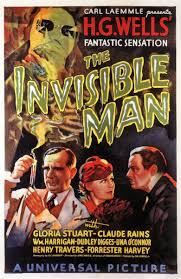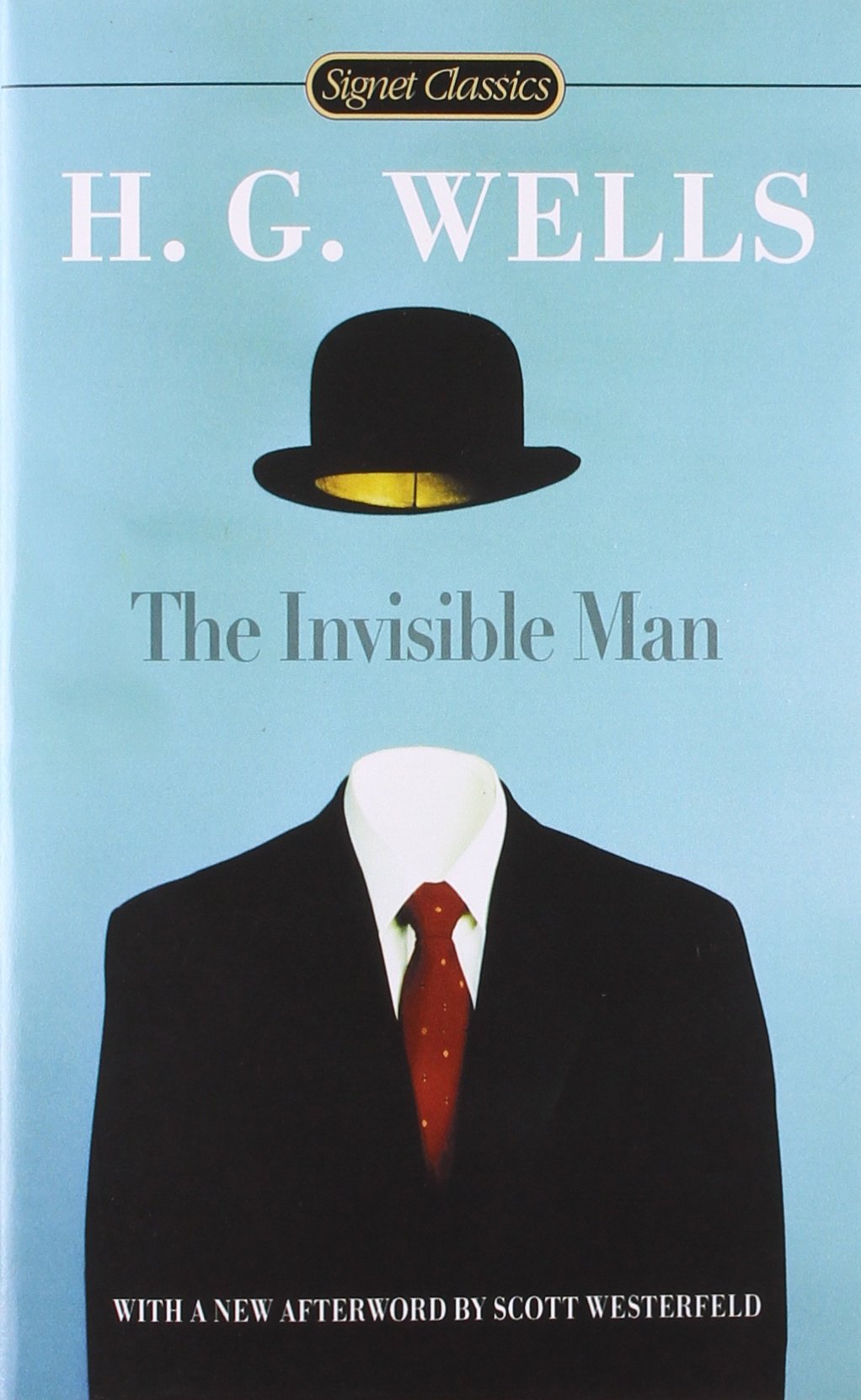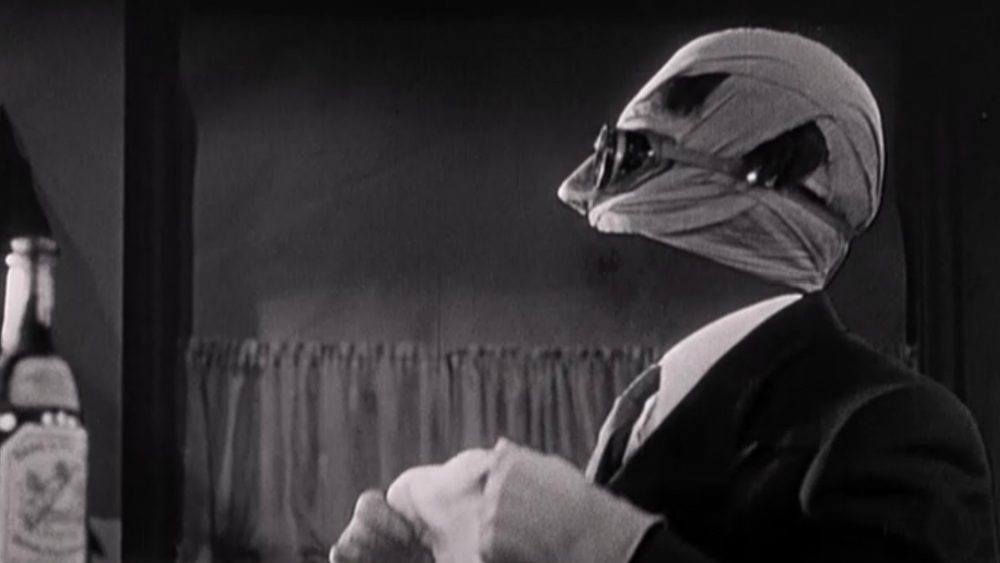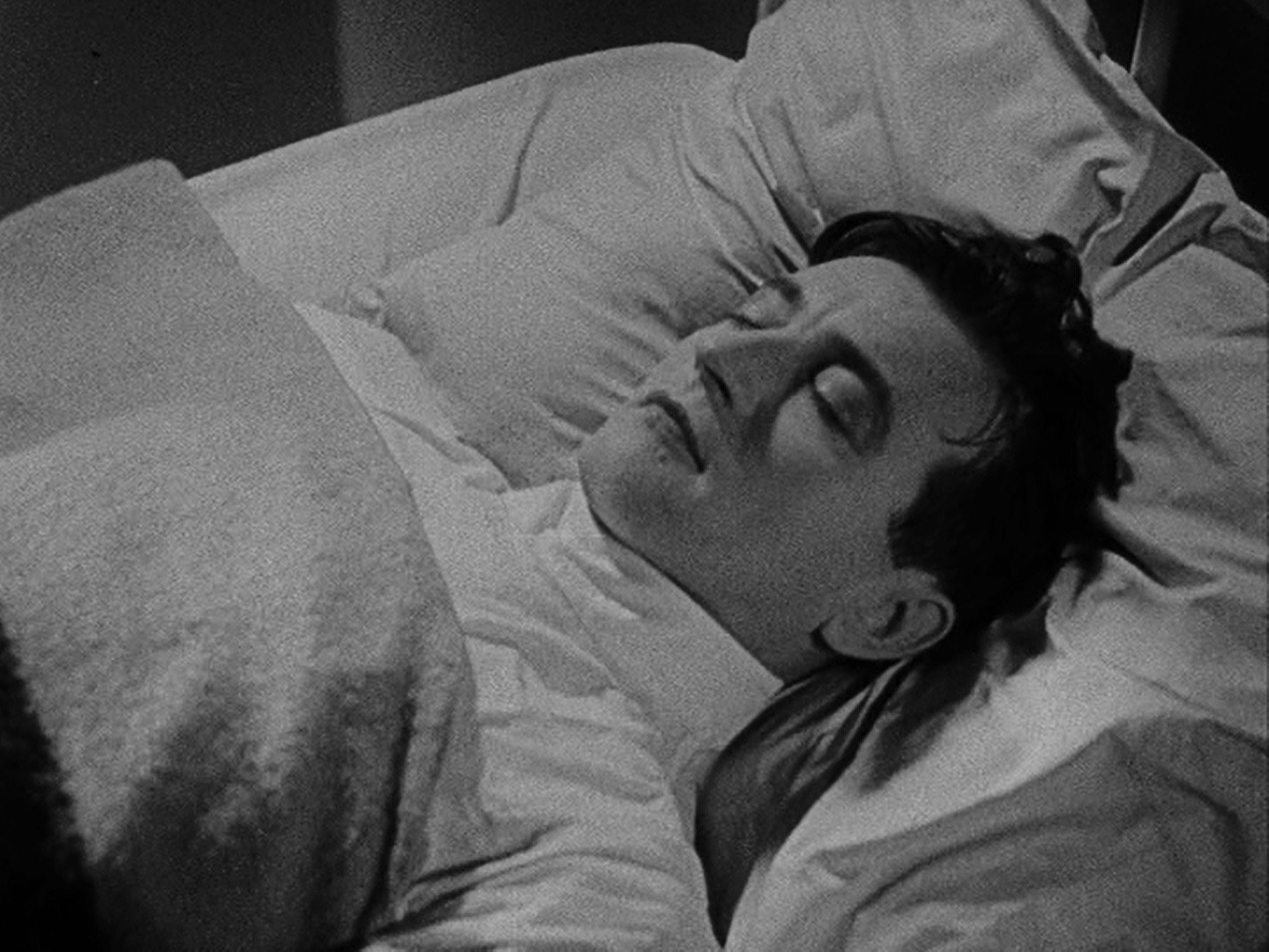From the IMDB: 1 hour 11 minutes, 7.4/10 from 23,534,
Genre schizophrenia here. Is it a horror movie or is it Sy Fy? Arguments over definitions are best because they have no end, and no point.

H. G. Wells published the novel ‘The Invisible Man’ (1897) first as a magazine serial and then as a title. His hand makes it Sy Fy, but when Universal filmed it, that studio’s association evoked Horror because Universal had specialised in that genre. Though British in look, it was made in the USA.

The film differs from the book in several ways. The first and most important is that the Invisible Man is mad from the beginning on film, whereas in the book he becomes more and more unhinged the longer he stays invisible, which may be due to the drugs he is taking for the pain that the invisibility drug causes and the other drugs he is taking trying to become visible again. On top of that he takes strychnine as a pain killer. Killer, indeed. This guy could give the wanna be druggies around Kings Cross lessons in shooting up.
In the film his ambition from the get-go is a Reign of Terror, because he likes having power over others. In the book he comes to this term in his frustration to control the environment so he can concentrate on research to find a way back to visibility. He grows ever more unstable and despicable, but it is a process.
The film gives him a love interest absent from the book. She is played by a luminous Gloria Stuart who later appeared in ‘Titanic’ (1997) and whose last credit was in 2004. There was a sabbatical between 1946 and 1975. There are many familiars in the cast, and some familiar footage that was used again later in other Universal pictures, like the train crash.
While the Invisible Man causes as much mayhem as the fraternity brothers at the end of the semester in the book, in the film the Reign of Terror is not merely a threat, he kills at least two people, including his would-be confederate Dr Kemp. Moreover, he causes a train to crash with countless death and injuries. He is beyond redemption even by the love of good woman.
The book has some discussion of invisibility as a way of being. See! Sartre is relevant, albeit cryptic. (It takes him hundreds of pages to be cryptic. Nausea is certainly relevant to Sartre.) There is no doubt that Wells knew the references to the Ring of Gyges in Plato’s ‘Republic’ and in some way thought he was dramatising something of that philosophical discussion.
The fraternity brothers cut that class, and so for their benefit here is a refresher: Glaucon says a person is only moral because the responsibility imposed by society. Persons free of consequences of their actions would behave selfishly, knavishly, piggishly in the manner of the Tweet in Chief. If an ordinary Josephine came across a ring that could make one invisible, she would get up to no good. Want to know what Plato replied? Read the book! Wells’s novel is an examination of what an invisible person would then do. Though Dr Griffen, the Invisible Man, would hardly consider himself an ordinary chap.
At times I thought of the Invisible Man as an alter ego for Wells himself, and took the study to be autobiographical in a way. This is not a standard interpretation, so do not crib it.
The special effects must have been mind-numbing in 1933. Objects floating in the air, like a telephone. A cigarette smoking itself in mid-air. An unbuttoned shirt dancing by itself. The bicycle riding along sans rider. But most of all the several unveilings when the invisible man removes the bandages that conceal his nothingness. Did Jean-Paul Sartre see this film? Bet he did.
 The Invisible Man unveils himself.
The Invisible Man unveils himself.
The denouement is the dealh of the Invisible Man, when the police cordon has finally tracked him down in the fresh snow and dealt him mortal injuries. His shoe prints were easy to track in the snow. Yes, shoe prints. But the shoes were not visible…

Lying in a hospital bed he gradually dissolves into view as the very young Claude Rains.
By the way, the cinematic invisibility of Claude Rains was achieved by wearing a black velvet body suit with no holes. None. Then putting the bandages on and then the clothes over the top. Altogether an uncomfortable and awkward business. Then he would be filmed against a matte, but the technical matters are best left to technicians. The point is that it was hard work being invisible on film just as invisibility was a curse to Griffin in the story.
Claude Rains was a young actor who had appeared in some silent films but who preferred the theatre and was content there. That is, until the Great Depression thinned theatre audiences to nearly nothing and income was hard to get. The Universal agent who negotiated the film rights with Wells agreed to an English lead and Rains, a near unknown then, was recruited. It was easy money for him and a free trip to the USA.
It made sense. A big name actor would be expensive and wasted since unseen until the very end in one shot. Indeed a big name actor might not wanted the part or demanded it be changed for more face time. Not even still photos before invisibility or flashbacks are used to show Griffin before. Plus the Invisible Man had to command the attention of the audience with his voice. Rains’s perfect diction and distinctive intonation did just that. He made it seem credible that he could dominate scene against visible actors where he was unseen, and so carry the audience with him.
Rains had done some screen tests earlier and they were terrible. He effected a declamatory style suited to nailing the back wall of a large theatre, entirely wrong for the camera, which magnifies everything. See Marshall McLuhan on hot and cold media for enlightenment, Mortimer. However his voice got the attention of the casting director and since he would not be seen, Rains’s emoting would not be seen. Moreover, the oral intensity of his emoting was in keeping with the Invisible Man’s madness.
In time, Rains liked earning a living in films and the sunshine, and adjusted his style to the camera. This story is a reminder of the differences between stage and film, and why some players prefer one to the other, and all find the change an effort.
Social invisibility has been a theme in literature and I expect somewhere there is a syllabus that brings some of it together. There is Fyodor Dostoevsky. ‘Notes from Underground’ (1864) and
Ralph Ellison, ‘The Invisible Man’ (1952). (Ross McDonald’s ‘The Underground Man’ is literally a man underground, buried.) Plus the other Universal films and their many imitators.
Skip to content
